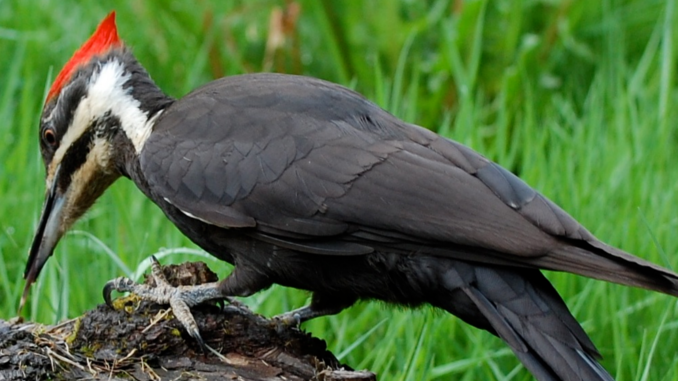
In the eighteenth and nineteenth centuries, the forests of eastern North America nearly disappeared to create lumber and farmland for the needs of the growing populations that had migrated here from Europe. Old growth timber, a critical habitat for many species, was virtually wiped out. Loss of this habitat was a threat to many kinds of birds, particularly woodpeckers.
Dryocopus pileatus, the Pileated [ PIE-lee-ey-tid ] Woodpecker, was among the species hardest hit by the habitat loss. By the early twentieth century the species was endangered. However, in the last hundred years D. pileatus has slowly rebounded. Conservationists believe the animal has adapted to second-growth forests and human encroachment. Although they are very shy birds, they can even be found in wooded areas around the edges of metropolitan areas as long as food is ample and they aren’t disturbed.
Pileateds are now considered common once again in much of their traditional range. They can be found most easily in the Atlantic seaboard states from Virginia south to Florida, and from there west through the Gulf Coast states up to and including the Piney Woods of East Texas. Their range does extend well beyond these coastal states, but they’re still considered uncommon elsewhere.
D. pileatus’s main food source lives in old trees and consists mainly of insects, but they also eat wild berries and nuts. Arthropods on the menu include termites, wood-boring beetle larvae, and other insects, but primarily the main course is ants – especially carpenter ants living in rotting, dead trees, although the birds are not above digging something up to eat out of an anthill of opportunity. They will sometimes forage on the ground if there’s no dense brush.
Part of the charm of these woodpeckers is their appearance and their calls. ‘Pileatus’ translates to ‘crested’ and, with it’s signature red crest, the pileated woodpecker looks and sounds something like the cartoon character Woody the Woodpecker of the forties and subsequent decades.
Approximately the size of a crow, D. pileatus is the second-largest woodpecker species in North America. Both male and female sport the bright red crest on their head. The male has matching red stripes on his cheeks, while the female has gray striped cheeks.
Pileateds peck rectangular-ish holes in trees to build their nests. The mating pair will only use the nest for one season, then abandon it to build a new one next year. The old nests are taken over by other bird species or mammals for nesting and shelter. Thus, many critters benefit from the big woodpecker’s industriousness and charitable habits.
There are many excellent and entertaining D. pileatus videos on YouTube, simply search for “pileated woodpecker call”, or try this one; “Singing Pileated Woodpecker Conroe Texas”.
The following audio files from The National Audubon Society are excellent examples of what Dryocopus pileatus sounds like in the wild (I never grow tired of listening to this bird):
• “short calls”
• “short calls”
• “long call”
• “flight call”
• “drums”
• “interaction calls“
• “nestlings“.
In my opinion, the call of the pileated is reminiscent of a tropical bird, such as a peacock (video). Compare the pileated calls to the peacock calls and let me know whether you agree that they have a certain similarity or not.
Question of the night: Do you have a favorite among the bird species?
